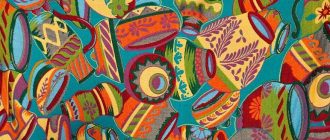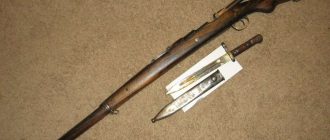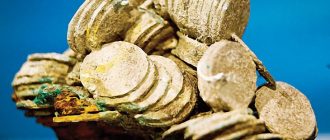It is not possible in this volume to expatiate fully upon all the reproductions of the various lines that fall properly under the heading of ceramics. My particular province being glass, I have not had occasion to devote much study to pottery and porcelain. All I shall attempt is to describe those fakes which are most frequently found in shops and are sometimes offered for sale as genuinely old ware.

On Plate 137 are pictured three tea sets in pink luster, showing different adaptations of the ever-popular House pattern. All three have been on the market for the past twenty or twenty-five years.
None shows the quality or the feeling of the originals. Many new articles may have an appearance of age until placed next to the really old.
On Plate 138 in the bottom row is what is described as “Sunderland Lustre Liverpool jugs.” The black decoration consists of the “shipwright arms” on one side, an old clipper ship on the reverse, with a coat of arms lettered JAMES LEECH in front.
These were made in three sizes. A critical examination of the ware itself would disclose its newness. The price to the trade was from $3.00 to $4.00, according to size.
In the center of the same illustration are pictured some new examples of silver resist, though these are now about thirty-five years of age. The tea set at the top of the page is “the very best Carlsbad China” in the “early American silver resist Berry decoration.” It is attractive enough, but true silver resist is difficult to reproduce.
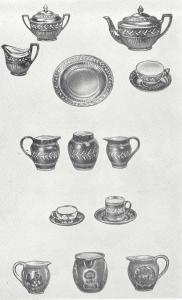
In the first place, the old ware is delicate, usually very light in weight, and the resist is applied differently. While this does not always tell the complete story it is, nevertheless, one way to judge.
Most copies of both silver and copper luster are much heavier than the old and the copyist is seldom careful as to the correct shapes. A student can easily detect the differences.
Cups and saucers were made in the same Berry pattern in gold luster, but they are too new looking to deceive anyone. The makers were not thinking of deception, but of meeting a popular demand at low prices.
On Plate 139 are shown some new English copper luster pieces which came in through Canada about ten years ago. The two pieces on the left are very heavy. I have seen numerous ocher pieces to match in shops, including a teapot and a creamer.
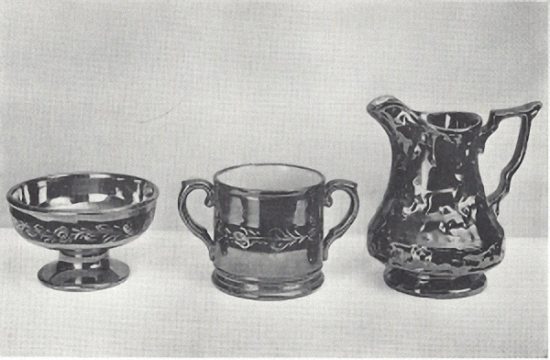
Dealers in ceramics as well as collectors had reason to complain during the early 1930′s, at the flood of imitations in Wedgwood coming into this country from Germany and Japan. You see them in certain antique shops as well as in many department stores and gift shops.
A number of years ago an importer who carried an exrensive line of them sent out circulars in which it was srated that “Wedgwood” was merely a generic item for that class of ware. He advertised his importations as “Wedgewood” (note an extra e inserted in the name) whereupon the New York a gems of the famous firm of Josiah Wedgwood & Sons, at the head of which is a direct descendant of the founder, took legal steps in the matter and obtained an injunction to prevent the misuse of the name.
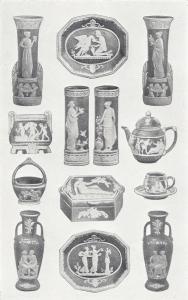
This action was not contested, and the importer was compelled to find another designation for the imitations. The Japanese product also was stopped from being offered as “Wedgwood.” The MADE IN GERMANY or MADE IN JAPAN is often scraped out or stamped over with the dealer’s name, when found in certain antique dealers’ shops.
Real Wedgwood has been plainly marked with the maker’s name uninterruptedly ever since 1769. In making the genuine a quite different technique is used. The blue body of the piece was made first, and the white cameo decorations applied afterward. This called for a high degree of skill. Modern practice has modified the method.
The cheaper grades of imitations are made in one piece in white, medallions and all, and the blue slip is applied where needed. Another line of this ware, but better executed, is illustrated on Plate 140. It is naturally much less expensive than the authentic. The inferior quality of the workmanship is plainly apparent and is the most rehable criterion.
You can see partly obliterated mold marks on the imitation which shows that the pieces have been pressed and not turned, as the genuine pieces are. Also, it is well to look on the inside of the imitations for indentations which show where the cameo decorations were impressed on the outside. Today reputable dealers will not, and the unscrupulous dare not, offer for sale as Wedgwood what is not Wedgwood.
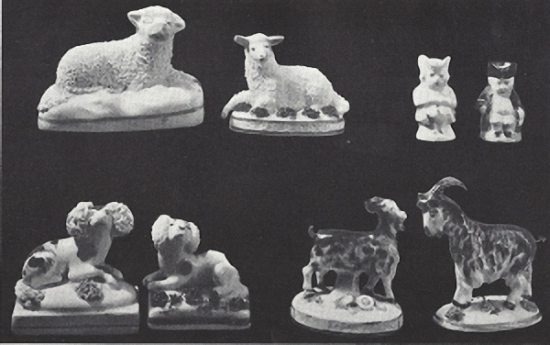
An importer brought over quite an extensive line of small Staffordshire animals about twelve years ago. Some of these are illustrated on Plate 141. The figure on the left in each case is a genuine old one. The new almost all carry the Chelsea gold anchor mark.
There is no extra charge for the anchor marks, which is the first thing the inexperienced collector looks for as a proof of age and authenticity. On the genuine, the anchor mark is underneath the glaze, not over it.
All of these imported figures are plainly marked GERMANY in a small ring in the center of the base. Our laws require that the name of the country of origin be so stamped. I have seen some of these with the “Germany” carefully eradicated. In some cases the unscrupulous seller will apply transparent varnish over the rough spot in the glaze caused by the erasure of the betraying mark. All these new imports are very bright and shining.
The gold bands about the bases also are too bright. Note how worn and soft looking the gold stripes appear on the base of the goat at the left on Plate 141. Often the pottery is yellower in the old ones, a sign of respectable age.
On Plates 142, 143, 144, 145, and 146 may be noted imported copies of Staffordshire animals and figurines which have been on the market for about twenty-seven years. On most of these the coloring is brighter and harsher.
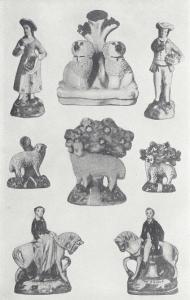
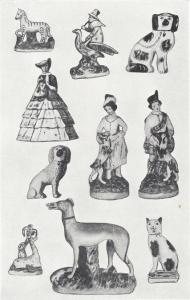
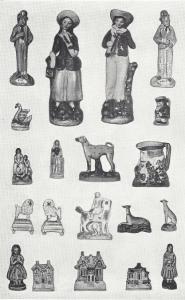
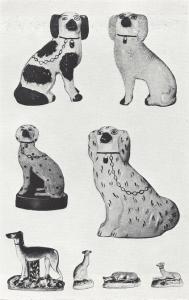
The paste never looks like the old. My considered advice to the new collector is to study carefully old specimens before going far afield. The new anchor-marked specimens will not give much trouble, but the older reproductions, without new marks, require closer scrutiny.
The small pebbled poodle pictured is an excellent copy. In my own collection, which numbers about two thousand, I have just two such dogs and they happen to be a pair-a right and a left.
Mine have collars but no locket, and each has a small hole in the base-utilized by the maker while the piece was in the process of drying. A good many of the copies do not have this hole, though some do. It requires an expert to tell the old from new. The faces of the old vary because they were hand decorated. So do the new. Original dogs of this period date between 1840-50. The squirrel on Plate 146 is an example of an exceedingly poor copy. As in many cases of reproductions, it displays very poor workmanship.
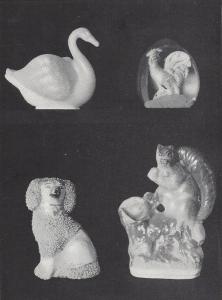
Lower row: Two fake Staffordshire animals
The painted face borders on the ludicrous. From the picture, it may be noted that the large flakes of paint have chipped off the lower part of the figure.
One could take any sharp object and peel it off. Squirrels have always been among the sought-after animals by collectors, but whoever produced the object illustrated could not hope to fool even a novice.
Also being reproduced are quantities of those quaint little Staffordshire cottage ornaments, which some collectors designate as the “naughty series.”
Among this group is one entitled, “Return at one o’clock in the morning”; “The Wedding night”; “The first in bed puts out the lights”; and so forth.
The new ones are easily recognized because the script in the title is larger and blacker, whereas in the old ones the lettering was never so large and heavy; it was more like a dainty script.
Mention of these new items is made here, so that collectors may know that copies of these cottage genre pottery pieces have been made and are marketed commercially.
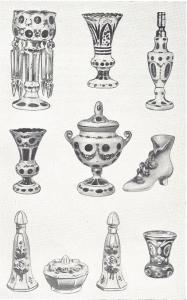
Quite a bit of this bric-a-brac goes to gift shops and is seldom seen in antique shops. Recently, sets of Dresden miniature pieces decorated with forget-me-nots have appeared.
These include a settee and two side chairs, a piano, small chair and a sprinkling pot. They average from two and three-quarters to three and one-half inches in height.
It should be kept in mind by young collectors that fine china and porcelain have been copied, imitated and faked for a great many years.
The earlier the copy the better the quality is apt to be, for being sold contemporaneously with the originals, they had to be well done.
It requires an expert, who knows not only the goods but the history of the trade, to tell the difference between certain old original pieces and the reproductions made fifty to seventy-five years ago by skillful artisans who knew nothing of mass production but did excellent work because sound craftsmanship was demanded.
Today’s makers of reproductions consider the profit and ignore quality. Perhaps they reason that ignorant buyers are more numerous than the well informed.

